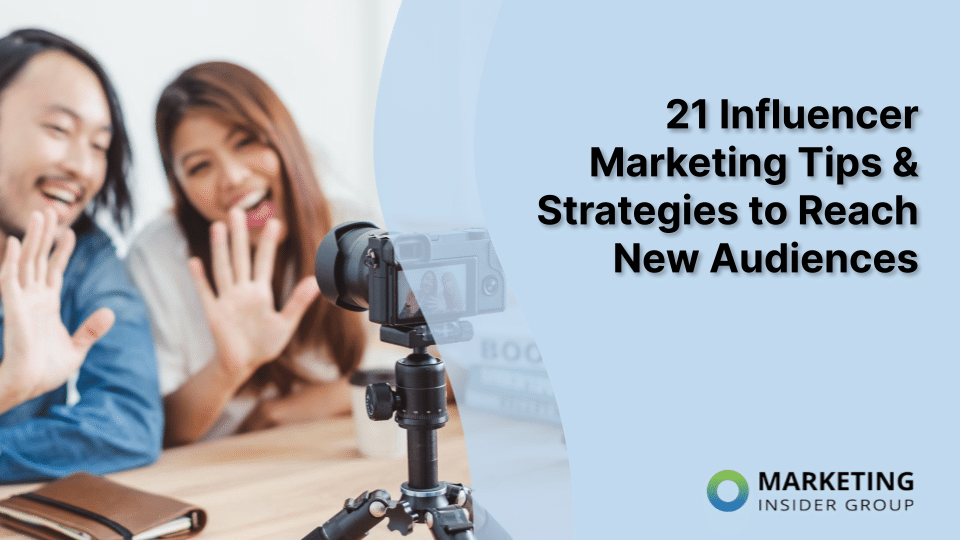
21 Influencer Marketing Tips & Strategies to Reach New Audiences
Influence cannot be gained overnight. Much like any other authority figure, a person is considered to be an influencer when they can influence audiences, which comes from being well-respected in the industry.
Becoming an influencer is achieved through hard work, passion, and excellent community management skills. Not to mention, having a captivating or likable personality never hurts.
By the book, influencer marketing utilizes key individuals with a following in their industries to distribute the content you’re creating. Partnering with an influencer often means you’re adopting a huge new audience. By having them promote your content you enter their sphere of influence. This gives you the potential to significantly increase your brand’s reach.
It’s a good idea to keep tabs not just on how many followers they have, but how active and engaged their followers are. An influencer is only as powerful as their audience makes them. Engagement levels are a good indicator of whether or not an influencer is worth pursuing.
According to a study by Tomoson, influencer marketing brings 51% better customers on average. This means that customers are more likely to spend more, be more loyal, and advocate for your brand when they’ve received the tick of approval from influencers.
In line with that, influencer marketing gives a strong return on investment (ROI). With an average return of $6.50 for every dollar your business spends, this strategy offers a significant channel for brands to build awareness, increase reach, and convert more sales.
Here’s a quick brush-up on influencer marketing from Learn with Shopify:
Quick Takeaways:
- Influencer marketing is the modern-day testimonial for your product or service
- The practice enables you to target your specific niche or demographic with credible influence
- Strategic implementation is necessary to maximize ROI
Why Do You Need Influencer Marketing?
Consumers trust recommendations from people they know above all else. This usually means friends, family, and colleagues.

However the growth of platforms like YouTube and Instagram has led to a massive wave of new influencers in all manner of niche industries, many of whom boast huge followings. Their recommendations are dictating what lots of us wear, buy, and do. They influence where we travel and how we get there. The music we listen to. Even the food we do, and don’t, eat. Their influence over the behavior of consumers is immeasurable, but immense.
Take, for example, “yogi enthusiast” Adriene Mishler whose YouTube channel “Yoga with Adriene” boasts just short of a million followers, and whose videos regularly top a million views.

Or AsapSCIENCE whose fun, lively, and unique approach to science has seen them amass more than four million YouTube subscribers in just over four years.

The fact is that while most of us do still value the opinion of those closest to us (in a list of “most trustworthy sources of information” a UK survey placed bloggers third, after family and friends, respectively), influencer marketing is a very, very powerful tool.
However, getting started with influencer marketing – and, more importantly, getting it right – is easier than said than done. You might think that picking a handful of influencers and sending your products will get the job done, but I’m sorry to tell you: it’s not that easy.
As with all forms of marketing, getting the most out of influencer marketing means planning, strategizing, monitoring, and measuring. Stick with me while I take you through a dozen strategies for getting influencer marketing right.
1. Establish Your Goals
Marketing only really works if you set out clear long and short-term goals and objectives. Influencer marketing is no exception. You have to understand what you want to achieve – I can’t stress that enough.
Before setting your goals, it’s imperative that you understand your target audience, your message, and the action (or actions) you want your audience to take. Ask yourself:
- What is our brand’s message?
- Who are we trying to reach?
- What do we want our audience to do as a result of the campaign?
It’s easy to wash over these sorts of questions, but it’s essential that you dig deep and construct meaningful answers. We know that we’re trying to reach potential new customers, but who are these customers? What are they interested in? What do they need and what will they respond to? Take the time to build detailed customer profiles.
While it’s a given that generating leads and sales takes priority, you should also look into other goals like boosting brand awareness, reaching new markets, and increasing your social media presence. Whatever your goal is, make sure to establish it well.
Once you’ve got clear, definitive answers to these questions, it’s time to lay out your goals. The trick here is to be as specific as possible. Wishy-washy targets such as “boost brand awareness” or “increase sales of product x” won’t cut it. They’re a given. Essentially meaningless. When it comes down to it, all marketing is about boosting brand awareness. And if you’re handing out freebies to influencers? It doesn’t take a genius to figure out that you want to boost that product’s sales.
Instead, set very specific goals or targets. Don’t say “drive more visitors to our website”, say “sell 1,000 of product x within one month of campaign launch” or “double our email marketing subscribers by x date.”
Will this guarantee you hit those goals? I wish it were that simple… In short: no. But specific goals will steer you in the right direction and help you to stay on track.
Key Takeaway: Before you do anything else, ensure you understand exactly who you’re trying to target with your campaign, and what actions you want your audience to take as a result of it. Next, steer your campaign in the right direction by setting out “SMART” goals (as defined above).
2. Create a Story
Storytelling is a huge part of successful marketing campaigns. People find it easier to relate to and understand your message better when the ideas and thoughts are organized into a traditional narrative.
Your target market will trust you and the influencer more when there’s authenticity and “humanity” in the story. These stories should elicit emotions and aim to strike a chord with your audience, addressing their interests, needs, and wants.
You can create a strong storyline with an intricate understanding of how your product or service improves the lives of your customers. Make it about the experience.
3. Do Your Research
Influencer marketing can also be called brand representation. These people will be the faces of your business, so it’s critical that you find out everything about them. If you come across red flags like controversial views or opinions, you might need to reconsider your options.
Furthermore, you’ll need to identify which channels these influencers are the most effective in. Of course, you’ll have to align the channel you want to maximize with the influencer dominating that platform.
Keep in mind that if a contracted influencer doesn’t appear to be supporting your objectives, it’s the brand’s fault for choosing that influencer. As a business, you should remember that you’re working with the influencer and not the other way around.
4. Pick the Right Influencer
Social media influencer marketing is becoming a popular and competitive profession, and you need to make sure to pick the right one that matches your needs. It wouldn’t be wise to choose an influencer who has zero correlation to your product.
But that doesn’t mean they need to be a perfect match either. If you sell men’s grooming products, you could approach a variety of influencers, from men’s lifestyle and fashion influencers to others who focus on manly hobbies like woodworking or cars.
It’s not just the influencer you need to analyze, you also need to look at their following. Gather demographic data to make sure your audience is connected to your target market. An influencer might have gained a following doing something that matches your product, but that audience is not interested in your product.
5. Be Relevant
It goes without saying that you should only contact influencers about opportunities that are relevant to both your audience and the influencer. However, according to Marketo, 50% of influencers reported that the majority of failed opportunities resulted from an irrelevant pitch. Clearly, a lot of us are still getting this wrong….
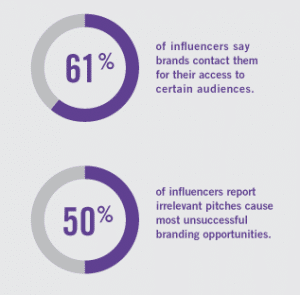
Remember that a great deal of an influencer’s reputation is staked upon them being picky about the products they test and recommend. If they start talking about items that aren’t a good fit for their audience, they risk alienating their audience and potentially, driving some of them away.
For this reason, it’s understandable that they would be ruthless about which brands they choose to work with and which products they decide to promote. If something doesn’t fit, they’ll just say no – and you should respect that.
That said, publicity from an influencer that doesn’t align with your brand is unlikely to benefit you in any significant way, either. Chances are, you’ll be able to find an “influencer” who’ll say “yes” – usually because they’re in it for the money or a freebie – even if the fit isn’t quite right. This is the easy way out – don’t take it.
Influencer marketing only works if the relationship is mutually beneficial. Don’t just start reaching out to everyone who has a blog. It’s okay – even encouraged – to be picky.
Key Takeaway: Before pitching an influencer, take the time to learn about their audience and to become properly acquainted with their work. Only pitch those that closely match your product, brand, and goals.
6. Work with Micro-Influencers
Allocate your marketing budget properly. Aiming for micro-influencers who have relatively small followings rather than pseudo-celebrities might yield better results. The most popular influencers in your industry will almost always be in high demand, so choosing to approach these elite influencers might end up being more trouble than it’s worth.
Micro-influencers are everyday consumers with significant social media followings. Although their reach may be limited when compared to their macro-influential counterparts, studies have found that they tend to get higher engagement rates and more interaction.
They’re also often easier to work with. After all, they probably don’t get approached much as influencers, so they won’t have any reason to have unreasonable expectations.
7. Build a Relationship First
It’s very rarely advisable to build a list of influencers you’d like to work with and just start emailing them. Most of the time, you’ll get far better results if you take steps to get onto each influencer’s radar – to show them that you care about their brand and business objectives, as well as your own.
This advice remains true, whatever you’ve got to offer. Seriously. You could be providing influencers with free yachts and you will still get better results if you take the time to build a relationship with them first.
Why?
Because if an influencer likes you, as well as what you’re offering them, they will work harder for you.

“Girl Lost in the City” aka journalist and blogger Emma Gannon recently said “I work harder for people I like. 100% of my effort is put in if I feel like I have a good relationship with the person I’m working for.”
Further, a recent survey by Glassdoor found that “80 percent of employees were motivated to work harder when they felt appreciated.”
In summary, contrary to popular belief, nice guys can, and do, finish first – a lesson that should be applied to all areas of your life, especially when asking people to do things that benefit you more than them.
Key Takeaway: Simple – be nice to people and take the time to build actual relationships with them. Don’t just see them as people who can do something for you – see them, and treat them, as real people – as potential friends – not just as business partners. Build an influencer army based on mutual trust.
8. Compensate Influencers Generously
Sometimes, simply providing influencers with a free product is enough to get them talking about you. Many more are looking for financial compensation. This is perfectly understandable – do you work for free? No? Then why should you expect anyone else to?
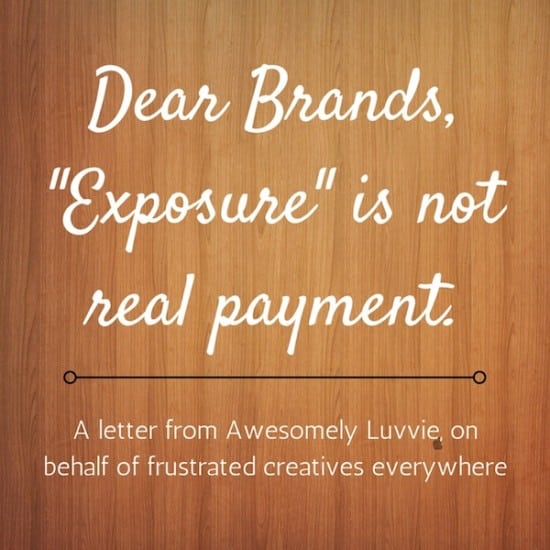
Many (if not most) of the more established influencers out there will be looking for financial compensation for their time. Be prepared for influencers to respond to your initial email with a simple “what’s your budget for this project?”
In fact, when asked what puts them off brands, over 80% of bloggers said “the brand expects me to work for nothing”.

Before you even get started with influencer marketing, decide on your budget – both your total budget, and the amount you’re willing to assign to each influencer.
I think it’s worth bearing in mind, however, that even though most influencers are going to want to talk money, the majority will also be very flexible with the amount they’re willing to accept. It’s about coming to an agreement that works for, and benefits, both of you.
Perhaps you can’t offer the amount of money an influencer would usually ask for. That’s okay – all is not automatically lost. There may be scope for the influencer to work for less money by reducing the service they offer.
That said, if you’re already quite influential yourself, and you’re only looking for a quick bit of exposure (like a single tweet), you might be able to persuade an influencer to help out simply by offering like-for-like exposure. You won’t know if you don’t ask.
Key Takeaway: Most influencers will want to be compensated financially for their time. Before you begin approaching influencers, set aside a budget that you can comfortably afford. However, once you start your outreach, don’t launch straight into talking about money – let the influencer be the one to bring it up in case the opportunity exists for you to arrange alternative means of compensation.
9. But Be Mindful of Your Budget
Negotiate influencer prices. While it’s safe to base everything on the rate card, it’s still recommended to small talk your way around your campaign’s cost.
Also, don’t forget to make use of what you already have. The product or service you’re marketing can also be beneficial to the influencer. Find the perfect balance of monetary compensation and collateral materials to turn your influencer into an effective brand advocate.
10. Make Content Worthy of Going Viral
Social media influencers have a unique opportunity when posting. If they create something special enough, it’s possible that post will go viral. Just because you’re paying for the post doesn’t mean it shouldn’t have the opportunity to go viral.
Work with the influencer to make something fun, entertaining, and unique, but still highlights your product. Even when working with a smaller influencer and a small budget, do your best to make a great looking video.
Focus on good editing, great lighting, and your influencer’s natural talents for making an awesome video.
Your best bet for going viral is producing a good video. If your influencer has experience with making videos, all the better. Video is great for engaging with their followers, is easily shareable across multiple platforms, and can keep people’s attention for more than a few seconds.
11. Make it Look Effortless
Ultimately, you should be trying to do influencer marketing without making it look like influencer marketing. The idea of tapping into a new audience is to make it seem as organic as possible. You really don’t want to give the impression that it’s all business or it’ll make your digital marketing campaign seem less authentic.
Remember, people connect with experiences, and the influencer should talk about your brand based on their own story. It’s the influencer’s personal opinion that you’re after, which (as much as possible) should never seem promotional.
12. Involve the Influencer
Always keep things transparent with influencers. They’re not just there to hit the “post” or “tweet” button. They have intrinsic knowledge about what makes their audiences tick, so you should keep them in the loop when making campaign-related decisions.
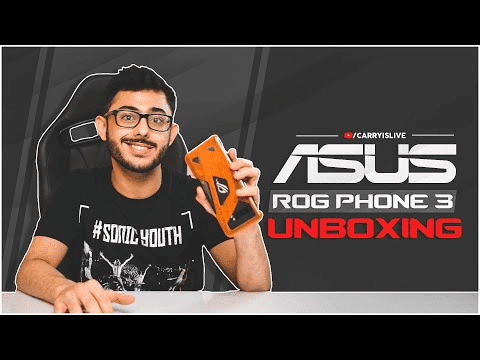
Source: Unbox Social
Be open-minded when it comes to their suggestions. These are influencers who’ve worked with numerous brands, and they should know what works. Involve them in the planning process whenever possible. You never know when they might be able to offer a unique perspective on something, potentially making your campaign more effective.
13. Allow Creative Freedom
When an influencer agrees to work with you to promote your product or service, they’re doing you a favor. I get that it doesn’t always feel like that – especially if there’s cash involved – but the fact is that whatever’s exchanging hands, they hold the power. Trying to control what they do and what they say about you can damage your relationship and drastically reduce the chance that they’ll agree to work with you again.
All that aside, influencers know their audience better than you. They know what makes their audience tick and what they will respond to. You don’t.
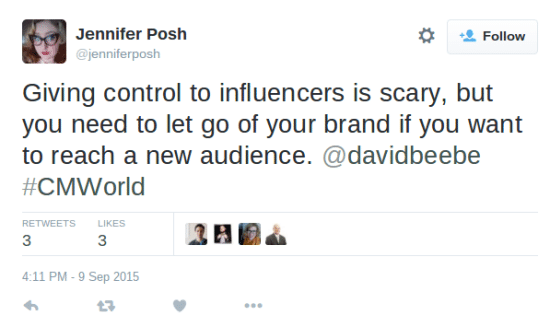
Influencers also know their community better than you do. They know what types of posts get the most engagement from their community and which ones fall flat.
Although it’s true that they’re working for your brand, you should still give them free reign (within reason) when it comes to how they want to approach specific campaigns. Any unnecessary guidelines will only work to restrict your campaign’s creative potential.
All that an influencer should need is a campaign brief and periodic reviews to ensure things are going according to plan. Provide them with information and imagery. Feel free to articulate your ideas. But beyond that, just let them do their job.
If you’re worried that an influencer’s work won’t “fit” your brand or do it justice, then you haven’t done your research properly. Go back to the drawing board and this time, identify and approach influencers that you feel you can trust to reflect your brand properly.
Key Takeaway: When you’re working with an influencer, remember that they know what’s best for their audience. Feel free to steer them in a particular direction, but don’t make demands or try to control what they ultimately decide to do.
14. Avoiding Negative Feelings with the #Ad Disclosure
Because of the FTC, anytime a social media influencer gets paid to promote a product, they have to disclose that it’s an ad. Most do this by including a #ad at the end of the post or as a part of a video in order to disclose it.
Many followers have negative reactions to seeing paid posts, though. Some will call the influencer a sellout, while others will purposefully ignore the post, and, if enough of a big crowd dislikes the post, it can cause actual damage to your brand.
The best way to avoid these negative feelings is to make sure the post, video, or whatever format you go with, matches what the influencer normally does. The ideal situation is that the followers would never even know it was a sponsored post without the #ad tag. It needs to feel like the influencer actually recommends the product, not just doing it for money.
In order to do this, give the influencer a lot of the creative control in the post. Give suggestions, provide feedback, and communicate your goals, and then let the influencer do what they do best. They know their audience and what will work with them and, if they have a lot of experience with doing sponsored posts, how to best avoid those negative feelings.
15. Value Engagement Over Followers
Followers aren’t exactly a bad metric. You wouldn’t want to work with an “influencer” that had 100 or so followers across the social channels they’re active on, for obvious reasons. However, that doesn’t mean “number of followers” is the only, or for that matter, the most important metric you should be looking at.
By all means, begin your research by identifying influencers that boast an impressive number of followers. But next, take a look at how engaged those followers are.
Why? Because it’s easy to fake a following. First of all, followers can be bought. For very little money. This page links to sites where 1,000 Twitter followers can be bought for between $12 and $19.
What’s more, it’s relatively easy to build a large following, simply by following lots of people yourself.
The real measure of how influential someone is, is how engaged their following is.
On YouTube, look not only at how many subscribers someone has, but how many people are viewing their videos.
On Twitter, look at the ratio of following to followers. A 1:1 ratio (or thereabouts) signals that their following has been gained largely by following others. Beyond that, look at the number of likes and retweets the “influencer” has, and how many actual conversations they’re engaged with on the platform.
On Instagram, take a look at the number of likes and comments someone’s images tend to attract.
It’s also important that the influencer has a healthy relationship with their audience. This involves significant levels of engagement on both sides, as well as a community-like system of support and debate.
Key Takeaway: Don’t be fooled by big numbers. Begin your search for influencers by finding people who are relevant to your brand and boast a big following, but next, narrow down your list in accordance with those that have the most engaged following.
Consider engagement rates and the types of engagement that these influencers are getting. Again, be mindful of quality. The context of their influence will dictate whether or not your campaign has the potential to convert.
16. Be Realistic
Influencers are not born equals. Pretty much everyone in digital would love Rand Fishkin, Wil Reynolds, or Danny Sullivan to talk about them, but for most of us, that’s just not realistic.

People like Rand, Wil and Danny are more than influencers – they’re celebrities. Are they going to get an Oscar invite? Probably not. But influence in digital doesn’t get much bigger than these guys.
Unless you’re already relatively well-known and respected yourself, trying to engage influencers of this caliber in your marketing is likely to lead to one of two things…
- Being ignored, or
- A very big bill.
As I mentioned just above, influencer marketing needs to be mutually beneficial, and the reality is that without klout or cash, you probably don’t have anything top-level influencers want or need.
Instead, move down a step or two. Target tier two or tier three influencers instead of tier ones. You’re looking for people that are respected in their industry and boast engaged followings, but that have the time and inclination to work with the “little people”. You’re also looking for the ones that are willing to do this without demanding huge fees.
This is what’s sometimes called “the power middle”:
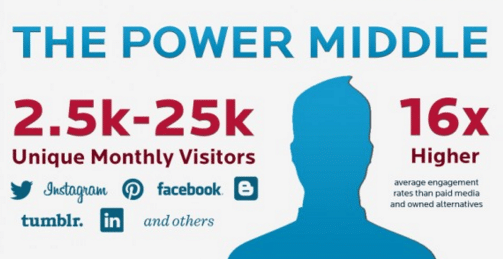
Tools like Followerwonk and Traackr can help you identify and connect with influencers at all levels.
Key Takeaway: Don’t target influencers that are at the very top of their game (unless you’re already pretty influential yourself, or have a big budget to work with). Target those that are a little further down the hierarchy – they’re more likely to be responsive, and less likely to demand big fees for their time.
17. Aim to Create Long-Term Partnerships
You might assume that the optimum strategy for getting the most out of influencer marketing is to work with as many influencers as possible with a single campaign. You’ll reach lots more people that way, right? Well, maybe. But that doesn’t make this strategy the most effective.
It makes tons more sense to work with the same influencer, repeatedly, over a long period of time. Why? Because each influencer’s audience might not bite right away. They’ll be exposed to your product just the one time, and if that single exposure doesn’t turn them into a customer, what then? Chances are they’ll forget about you and never become a customer.
On the other hand, if that customer is exposed to your brand subtly, but regularly, over a period of time, they will start to remember you. They might not bite (aka, buy) right away. They might not buy in a week, a month, or a year. But if at some point, they decide they want a product like yours, chances are they’ll remember your brand. What happens next? I think it goes without saying that there is a very good chance they’ll choose to buy from you.
This ties right in with strategy number five, just above: build a relationship first. The most valuable influencer marketing campaigns are those that last. This sort of strategy might not offer you the same sort of instant gratification you’ll get by getting your product into the hands of lots of different influencers, but in the long-run, patience will pay.
Key Takeaway: Aim to work with a handful of influencers over an extended period of time rather than lots of influencers on a one-time basis.
18. Monitor Your Campaigns & Track Results
It’s critical that you’re able to isolate the effects of your influencer marketing campaign. Make sure you’re setting up tracking codes and channel reports, so you know exactly what your ROI is.
You can use various tools to keep track of your influencer marketing efforts. But don’t get distracted by metrics that don’t matter. Keep your focus on the key goals and objectives laid out in your influencer marketing plan.
The most effective marketing is marketing that’s monitored and tracked. It’s simple really: it’s about understanding whether or not what you’re doing is actually getting you results. You need to know whether an increase in traffic or revenue can be attributed to your marketing or to something else. And if you’re not seeing improvements across the board, you need to be able to determine why.
You also need to understand which campaigns are performing best, and which ones are performing worst.
Arguably, the simplest way to track how many sales an influencer marketing campaign is driving is with a unique code. You simply provide the influencer with an offer code that’s exclusive to them, and track how many sales are completed using the code.
This isn’t foolproof – offer codes get passed around the web and consumers can wind up using the code despite never having come across the influencer you’re working with, or any of their content.
A more reliable alternative is to provide each influencer with a trackable, tagged URL that they share with their audience. An affiliate tracking program like WP Affiliate can automate the process of creating these URLs, in addition to tracking sales by influencer.
Of course, these strategies only track the traffic your influencer campaigns drive to your site and the sales that result from them. You might also be interested in monitoring the reach and engagement of your campaigns – particularly in the case of long-term campaigns in which you’re looking to increase exposure to your brand over time.
I’m a big fan of SharedCount – it’s an excellent (and free) tool for instantly checking how many times a page has been shared on Facebook and Pinterest. Alternatively, you can use a tool like Mention to track mentions of your brand, or for something a little more comprehensive (but still affordable) I’d encourage you to take a look at Trackur.
Key Takeaway: Track everything. It’s the only way you can establish which campaigns are working and which aren’t – a pretty vital move if you want to avoid spending money on campaigns that aren’t driving a good return.
19. Don’t Judge Too Quickly
Just a second ago, I told you to track everything. And while that’s advice my businesses live and die by, I also don’t believe you should judge the results of any influencer marketing campaign too quickly.
Influencer marketing isn’t like paid search, through which you can instantly determine the ROI of an ad or campaign. Influencer marketing is a little more like SEO – trickier to credit a result with an action, and longer to take effect.
If you’re following the strategies above, you should be striving to build long-term relationships with influencers. Let’s assume you are: don’t be too quick to decide if a campaign is working. If you feel things aren’t heading in the right direction, talk to the influencer in question before deciding to pull the plug. They may be able change their approach or reassure you as to when you can expect to begin seeing results.
Key Takeaway: Don’t be disheartened if your influencer campaigns don’t start getting results right away. It can take time to see an ROI. If you’re considering pulling the plug on a campaign, speak to the influencer about your concerns first.
20. Follow Up on the Influencer’s Work
If you drop big money on an influencer and see a big return from it, don’t let that momentum run out. Have a plan to keep pushing to get the most out of your new business.
That might include further influencer posts, landing pages specifically designed to work with the influencer’s followers, and working on transforming one time purchasers into lifetime customers. Influencers are great at not just attracting new customers, but improving brand loyalty among those new customers.
If you do get a big influx of new customers, make sure to include them into any email lists or workflows you have for bringing back customers to your business.
21. Start Small, Measure Results, Go Bigger
The first time you dip into influencer marketing, you won’t really know what kind of results you’ll get. Before you go recruiting a big time influencer, somebody with a celebrity status, you need a good idea what you are getting into. Going for a large influencer right off the bat could lead to too much demand to keep up with, and create a big mess for your business.
Start with smaller influencers so you can get an idea of overall results from each campaign you do. Out of their total following, how many converted into leads or customers?
Be sure to track your campaigns, analyze your results, and try again. You should do your experimenting with what works best when working with smaller influencers, including what platforms to use, what type of content to make, and best times to post.
Then, once you have a good idea what kind of results to expect and which tactics work best, you approach a larger influencer. That way, you can be prepared for a massive increase in sales and get the most out of the much larger influencer.
The Wrap
Setting up and executing an influencer marketing program is a complex task for any brand. But laying the right foundation, tracking your efforts, and covering all your bases makes it a lot more straightforward to implement.
Undoubtedly, influencer marketing is a very useful tool for businesses, big and small. It’s great for increasing your brand’s reach, gaining more leads, and boosting your sales. But just like every other tool, if done incorrectly, influencer marketing can become a waste of money, or even hurt your business. If you plan on utilizing influencer marketing, here are some tips to make sure you get the most out of it.
Be sure to make use of the right tools and best practices when it comes to implementing your influencer marketing campaign. Planning ahead will maximize your chances of success with reaching new audiences. Get after it!
Are you actively using influencer marketing? What strategies have you been using and how effective have they been? Take a minute to share your experiences with us please.
Do you want to use some of the marketing strategies seen here on MIG’s site but need some help or advice? Marketing Insider Group has a team of 35+ experienced writers ready to produce content for YOUR business. Check out our weekly blog content service or schedule a free consultation.

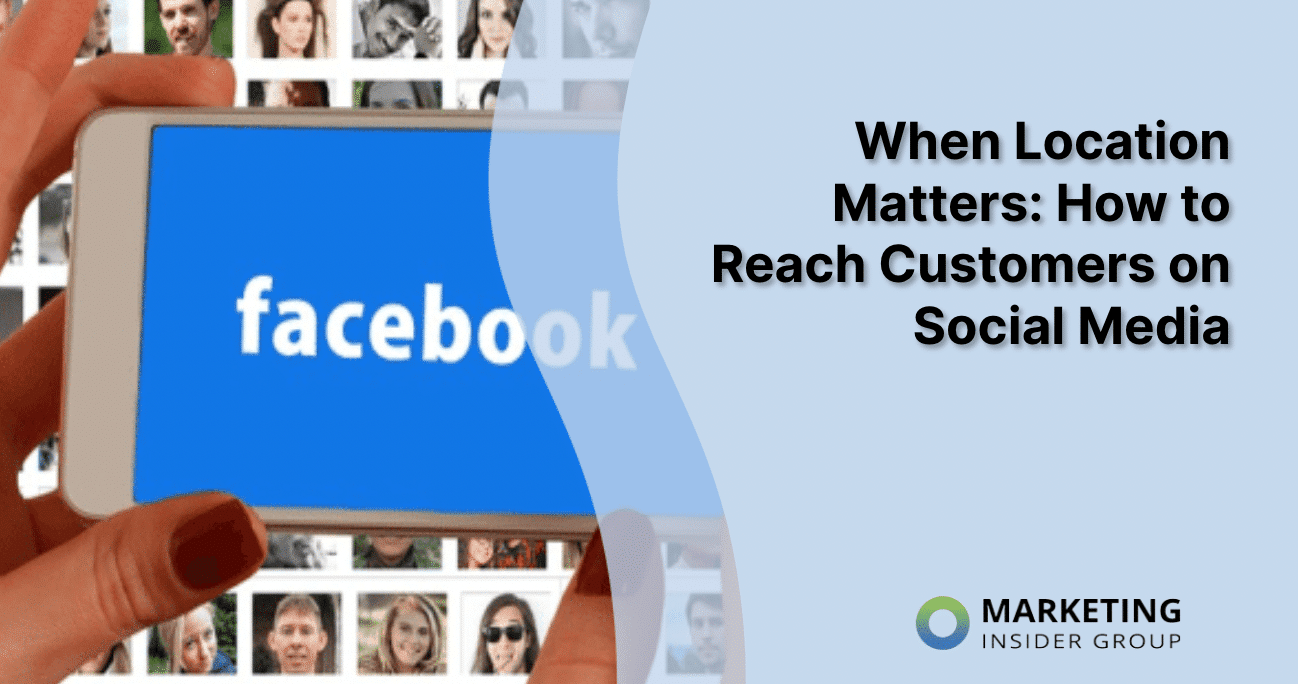





Thanks for sharing – reaching new audiences is a never-ending challenge, and competition among brands gets harsher and harsher every day!
Personally speaking, I find micro-influencers both more approachable and laser-focused than their most famous conterparts – generally speaking, big names don’t have enough time to build those relationships your brand probably needs.